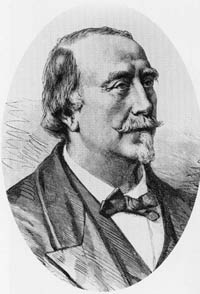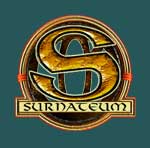|
|
Sensitives who join the Surnateum and the Institute have
access to new documents recently acquired by the Curator.
Here we will merely list the rarest works.
Please contact the Librarian for other entries.
 Inv.SBB/DR/lf-30141 Inv.SBB/DR/lf-30141
Les Mystères de la Science
by Louis Figuier (1860) Vol.2 Aujourd'hui
(Paris, A la Librairie Illustrée)
Acquired by the Surnateum in 2002
Description:
A scientific work which seeks to demonstrate the 'heresy' of certain
incomprehensible phenomena, such as the Marvels of Cagliostro, animal
magnetism, mystical magnetisers, the electric girl, the sympathetic
snails, spirit-rappers, table-turning , mediums, spiritualists and
hypnotism.
Note:
1. Louis Figuier (Montpellier, 1819 ~ Paris, 1894)
 The
nephew of Pierre-Oscar Figuier, professor of chemistry at the School of
Pharmacy in Montpellier, he became a doctor of medicine (1841) and earned
his doctorate in pharmacy and chemistry (1844-1853) and a doctorate in
physical sciences (1850). He was a professor at the School of Pharmacy
in Montpellier, followed by a stint (starting in 1853) at the School of Pharmacy in Paris.
His research brought him into opposition with Claude Bernard.
In the wake of refutations of his work, he abandoned his research and
concentrated on making science accessible to laymen. In 1855, he
became the scientific editor at La Presse. In 1859 he founded an
annual publication,
L'Année scientifique et industrielle (or Exposé annuel
des travaux), in which he listed scientific output for the year in
question. He wrote many books, several of which were very succesful: Exposition et histoire des principales
découvertes scientifiques modernes (1851), L'Alchimie et les
Alchimistes (1854), Les applications nouvelles de la Science à
l'Industrie et aux Arts (1856), Les Grandes Inventions anciennes et
modernes (1861), Le Savant du foyer (1862), La Terre avant le déluge
(1863), La Terre et les mers (1864), Les Merveilles de la science (1867-1891). The
nephew of Pierre-Oscar Figuier, professor of chemistry at the School of
Pharmacy in Montpellier, he became a doctor of medicine (1841) and earned
his doctorate in pharmacy and chemistry (1844-1853) and a doctorate in
physical sciences (1850). He was a professor at the School of Pharmacy
in Montpellier, followed by a stint (starting in 1853) at the School of Pharmacy in Paris.
His research brought him into opposition with Claude Bernard.
In the wake of refutations of his work, he abandoned his research and
concentrated on making science accessible to laymen. In 1855, he
became the scientific editor at La Presse. In 1859 he founded an
annual publication,
L'Année scientifique et industrielle (or Exposé annuel
des travaux), in which he listed scientific output for the year in
question. He wrote many books, several of which were very succesful: Exposition et histoire des principales
découvertes scientifiques modernes (1851), L'Alchimie et les
Alchimistes (1854), Les applications nouvelles de la Science à
l'Industrie et aux Arts (1856), Les Grandes Inventions anciennes et
modernes (1861), Le Savant du foyer (1862), La Terre avant le déluge
(1863), La Terre et les mers (1864), Les Merveilles de la science (1867-1891).
In his lifetime,
Louis Figuier was as famous as Jules Verne (who was his assistant at
the university). The newspaper Le Temps (in its edition of 28
January 1884) compared the two men: one a novelist and the other a man
"who focused on popularising science".
2. The sympathetic snails
Jules Allix (1818-1897) was born in Fontenay-le-Comte to a
merchant/ironmonger father. He would earn a reputation for himself
for his extreme republican views.
After standing as a 'communist' candidate in Vendée - a rather rash
move - he organised extravagant conspiracies under the Second Empire.
The authorities had him thrown in prison. He was involved in the Paris
Commune as a colonel commanding a legion but was removed due to his eccentric
behaviour. The judges in Versailles, amazed by his rhetoric,
had him locked up in Charenton. He was released in 1876. Jules Allix
then served as an activist in Maria Deraismes' League of Women.
But he was also an engineer with plenty of ideas and inventions.
His theory of sympathetic snails amused the Paris smart set. He claimed
that two snails which have mated always remain in permanent
communication, no matter how far apart they are. The idea was that in
every large city there would be a box of snails, each one representing a
letter of the alphabet. If you are in Paris and you touch snail E, then
snail E in Beijing or Timbuktu will move at the same time. He saw this
as a more economical system of communication than the Morse telegraph.
He developed several 'perpetual engines', registered a plan to
transform Paris into a seaport and, in 1895, submitted an equally
grandiose scheme to the Municipal Council of Saumur to dig a new port in
the grassland of the Le Thouet region, linked to the Loire river via a navigable
tunnel. This project in Saumur seemed to be linked to his brother.
Jules Allix was a close friend of the Hugo family during their exile
on Jersey. In 1854-1855, Allix, along with his brother and sister, took part in
a spiritualist experiment involving rapping tables. The session ended with a
Jules suffering a fit of madness.
[Sources: Le Courrier de l'Ouest, 23-XII-1986 , Roman d'Amat,
Dictionnaire
de biographie française, 1936]
In a bid to follow in the footsteps of Jules Allix and Louis Figuier
and test the telepathic powers of snails, the staff of the Surnateum
must refrain from transmitting the words 'garlic butter' and 'escargot'
so as not to trigger a panic among their subjects.

|







 The
nephew of Pierre-Oscar Figuier, professor of chemistry at the School of
Pharmacy in Montpellier, he became a doctor of medicine (1841) and earned
his doctorate in pharmacy and chemistry (1844-1853) and a doctorate in
physical sciences (1850). He was a professor at the School of Pharmacy
in Montpellier, followed by a stint (starting in 1853) at the School of Pharmacy in Paris.
His research brought him into opposition with Claude Bernard.
In the wake of refutations of his work, he abandoned his research and
concentrated on making science accessible to laymen. In 1855, he
became the scientific editor at La Presse. In 1859 he founded an
annual publication,
L'Année scientifique et industrielle (or Exposé annuel
des travaux), in which he listed scientific output for the year in
question. He wrote many books, several of which were very succesful: Exposition et histoire des principales
découvertes scientifiques modernes (1851), L'Alchimie et les
Alchimistes (1854), Les applications nouvelles de la Science à
l'Industrie et aux Arts (1856), Les Grandes Inventions anciennes et
modernes (1861), Le Savant du foyer (1862), La Terre avant le déluge
(1863), La Terre et les mers (1864), Les Merveilles de la science (1867-1891).
The
nephew of Pierre-Oscar Figuier, professor of chemistry at the School of
Pharmacy in Montpellier, he became a doctor of medicine (1841) and earned
his doctorate in pharmacy and chemistry (1844-1853) and a doctorate in
physical sciences (1850). He was a professor at the School of Pharmacy
in Montpellier, followed by a stint (starting in 1853) at the School of Pharmacy in Paris.
His research brought him into opposition with Claude Bernard.
In the wake of refutations of his work, he abandoned his research and
concentrated on making science accessible to laymen. In 1855, he
became the scientific editor at La Presse. In 1859 he founded an
annual publication,
L'Année scientifique et industrielle (or Exposé annuel
des travaux), in which he listed scientific output for the year in
question. He wrote many books, several of which were very succesful: Exposition et histoire des principales
découvertes scientifiques modernes (1851), L'Alchimie et les
Alchimistes (1854), Les applications nouvelles de la Science à
l'Industrie et aux Arts (1856), Les Grandes Inventions anciennes et
modernes (1861), Le Savant du foyer (1862), La Terre avant le déluge
(1863), La Terre et les mers (1864), Les Merveilles de la science (1867-1891).